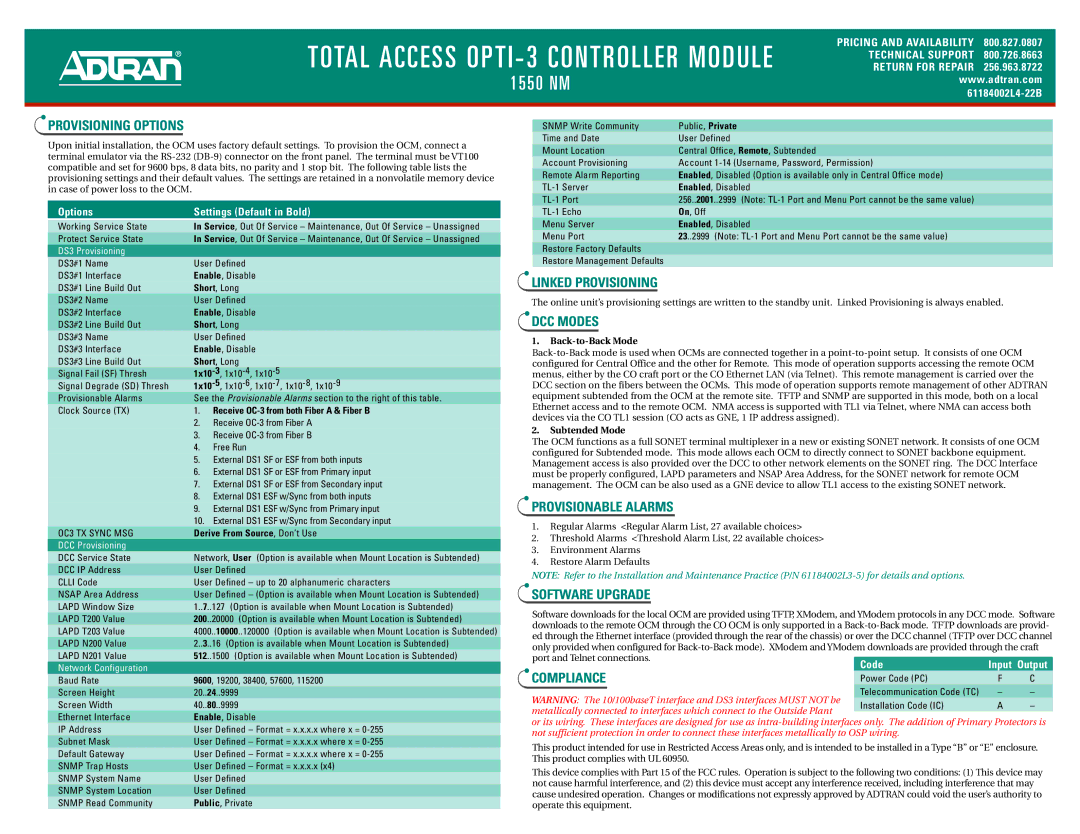
TOTAL ACCESS OPTI - 3 CONTROLLER MODULE
1550 NM
PRICING AND AVAILABILITY 800.827.0807 TECHNICAL SUPPORT 800.726.8663 RETURN FOR REPAIR 256.963.8722 www.adtran.com
PROVISIONING OPTIONS
Upon initial installation, the OCM uses factory default settings. To provision the OCM, connect a terminal emulator via the
Options | Settings (Default in Bold) | |
|
| |
Working Service State | In Service, Out Of Service – Maintenance, Out Of Service – Unassigned | |
Protect Service State | In Service, Out Of Service – Maintenance, Out Of Service – Unassigned | |
DS3 Provisioning |
|
|
DS3#1 Name | User Defined | |
DS3#1 Interface | Enable, Disable | |
DS3#1 Line Build Out | Short, Long | |
DS3#2 Name | User Defined | |
DS3#2 Interface | Enable, Disable | |
DS3#2 Line Build Out | Short, Long | |
DS3#3 Name | User Defined | |
DS3#3 Interface | Enable, Disable | |
DS3#3 Line Build Out | Short, Long | |
Signal Fail (SF) Thresh | ||
Signal Degrade (SD) Thresh | ||
Provisionable Alarms | See the Provisionable Alarms section to the right of this table. | |
Clock Source (TX) | 1. | Receive |
| 2. | Receive |
| 3. | Receive |
| 4. | Free Run |
| 5. | External DS1 SF or ESF from both inputs |
| 6. | External DS1 SF or ESF from Primary input |
| 7. | External DS1 SF or ESF from Secondary input |
| 8. | External DS1 ESF w/Sync from both inputs |
| 9. | External DS1 ESF w/Sync from Primary input |
| 10. External DS1 ESF w/Sync from Secondary input | |
OC3 TX SYNC MSG | Derive From Source, Don’t Use | |
DCC Provisioning |
|
|
DCC Service State | Network, User (Option is available when Mount Location is Subtended) | |
DCC IP Address | User Defined | |
CLLI Code | User Defined – up to 20 alphanumeric characters | |
NSAP Area Address | User Defined – (Option is available when Mount Location is Subtended) | |
LAPD Window Size | 1..7..127 (Option is available when Mount Location is Subtended) | |
LAPD T200 Value | 200..20000 (Option is available when Mount Location is Subtended) | |
LAPD T203 Value | 4000..10000..120000 (Option is available when Mount Location is Subtended) | |
LAPD N200 Value | 2..3..16 (Option is available when Mount Location is Subtended) | |
LAPD N201 Value | 512..1500 (Option is available when Mount Location is Subtended) | |
Network Configuration |
|
|
Baud Rate | 9600, 19200, 38400, 57600, 115200 | |
Screen Height | 20..24..9999 | |
SNMP Write Community | Public, Private | |
Time and Date | User Defined | |
Mount Location | Central Office, Remote, Subtended | |
Account Provisioning | Account | |
Remote Alarm Reporting | Enabled, Disabled (Option is available only in Central Office mode) | |
Server | Enabled, Disabled | |
Port | 256..2001..2999 (Note: | |
Echo | On, Off | |
Menu Server | Enabled, Disabled | |
Menu Port | 23..2999 (Note: | |
Restore Factory Defaults |
| |
Restore Management Defaults |
| |
LINKED PROVISIONING
The online unit’s provisioning settings are written to the standby unit. Linked Provisioning is always enabled.
DCC MODES
1.Back-to-Back Mode
2.Subtended Mode
The OCM functions as a full SONET terminal multiplexer in a new or existing SONET network. It consists of one OCM configured for Subtended mode. This mode allows each OCM to directly connect to SONET backbone equipment. Management access is also provided over the DCC to other network elements on the SONET ring. The DCC Interface must be properly configured, LAPD parameters and NSAP Area Address, for the SONET network for remote OCM management. The OCM can be also used as a GNE device to allow TL1 access to the existing SONET network.
PROVISIONABLE ALARMS
1.Regular Alarms <Regular Alarm List, 27 available choices>
2.Threshold Alarms <Threshold Alarm List, 22 available choices>
3.Environment Alarms
4.Restore Alarm Defaults
NOTE: Refer to the Installation and Maintenance Practice (P/N
SOFTWARE UPGRADE
Software downloads for the local OCM are provided using TFTP, XModem, and YModem protocols in any DCC mode. Software downloads to the remote OCM through the CO OCM is only supported in a
port and Telnet connections. |
|
|
| |
Code | Input | Output | ||
COMPLIANCE | ||||
Power Code (PC) | F | C | ||
| Telecommunication Code (TC) | – | – |
WARNING: The 10/100baseT interface and DS3 interfaces MUST NOT be
Screen Width | 40..80..9999 |
Ethernet Interface | Enable, Disable |
metallically connected to interfaces which connect to the Outside Plant
A –
IP Address | User Defined – Format = x.x.x.x where x = |
Subnet Mask | User Defined – Format = x.x.x.x where x = |
Default Gateway | User Defined – Format = x.x.x.x where x = |
SNMP Trap Hosts | User Defined – Format = x.x.x.x (x4) |
SNMP System Name | User Defined |
SNMP System Location | User Defined |
SNMP Read Community | Public, Private |
or its wiring. These interfaces are designed for use as
This product intended for use in Restricted Access Areas only, and is intended to be installed in a Type “B” or “E” enclosure. This product complies with UL 60950.
This device complies with Part 15 of the FCC rules. Operation is subject to the following two conditions: (1) This device may not cause harmful interference, and (2) this device must accept any interference received, including interference that may cause undesired operation. Changes or modifications not expressly approved by ADTRAN could void the user’s authority to operate this equipment.
